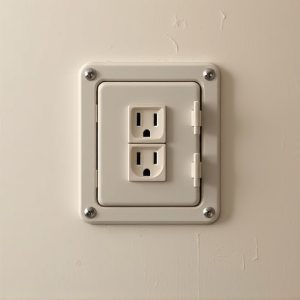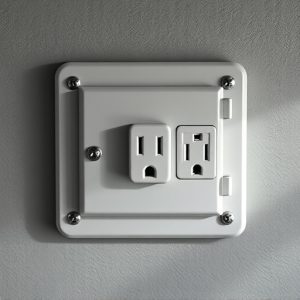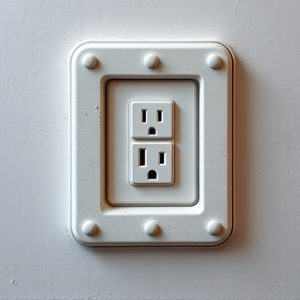Mastering Hidden Wall Safe Outlet Installation: A Homeowner’s Guide to Security and Safety
To install a hidden wall safe outlet securely and conveniently at home, carefully select an inconspi…….
To install a hidden wall safe outlet securely and conveniently at home, carefully select an inconspicuous location that's both accessible and free from moisture. Use a stud finder to identify sturdy points within the wall's wooden framing for anchoring the safe. Mark and cut an opening with a reciprocating saw, then repair the area aesthetically. For secure installation, professional assistance can be beneficial. Ensure the safe's electric lock or power-operated features are near an existing outlet, and consider a backup battery pack for uninterrupted access. Post-installation, verify the safe's functionality and maintain a record of stored items. Remember to integrate the safe's power cable with the outlet, keeping the electrical system intact by disconnecting power, connecting cables correctly, and resealing the back plate. Place the safe so it's level, stable, and at a height that deters unauthorized access while remaining user-friendly for those who should have access. Additionally, consider using a surge protector to safeguard against power surges. Positioning your hidden wall safe outlet following these steps will enhance your home security by providing a discreet yet functional storage solution for valuable items.
secure your valuables effectively with a hidden wall safe outlet. This article provides comprehensive guidance on best practices for installing a discreet wall safe at home, ensuring your belongings remain protected. From essential safety and placement tips to a detailed step-by-step guide, learn how to seamlessly integrate a wall safe outlet into your residential setting. Safeguard your assets with the knowledge presented in this informative piece on residential wall safe installation.
Best Practices for Installing a Hidden Wall Safe Outlet at Home
When installing a hidden wall safe outlet at home, it’s crucial to prioritize security and convenience for optimal performance. Begin by selecting an inconspicuous location that is not easily noticeable yet accessible when needed. Ensure the area is free from moisture to prevent damage to the safe’s mechanisms. Next, measure the dimensions of your hidden wall safe outlet to determine the required cutout in the wall. Use a stud finder to locate framing members within the walls for secure anchoring. Mark the intended cutout area and carefully use a reciprocating saw or similar tool to create the opening, being mindful to follow the contours of the safe’s design.
After cutting the opening, apply a coat of paint or wallpaper over the new surface to maintain the visual consistency of your room. Once dry, insert the safe into the cutout and anchor it to the framing members using the provided hardware. It’s advisable to have a professional assist with this step to ensure the safe is securely mounted. After installation, plug the safe into the electrical outlet if it has an electric lock or power-operated features. Verify that all functional aspects of the safe are working correctly. Lastly, consider adding a backup battery pack to maintain access to your valuables in case of a power outage. Adhering to these best practices will help ensure that your hidden wall safe outlet is both secure and user-friendly.
Step-by-Step Guide to Securing Your Home with a Wall Safe Installation
To enhance the security of your valuables, a wall safe can be an effective solution. Here’s a step-by-step guide to installing a hidden wall safe outlet in your home, ensuring your possessions remain secure and out of sight.
Begin by selecting a location for your wall safe outlet that is both inconspicuous and easily accessible. Ensure the chosen spot is flat against the wall; this will facilitate a more stable installation. Use a stud finder to locate the wooden studs within your walls, as these will provide a solid anchor point for the safe. Mark the spots on the wall where you will drill pilot holes for the screws that will hold your safe in place.
Next, remove the back plate of the electrical outlet where you intend to install the wall safe outlet. This will allow you to feed the power cable from the safe into the existing wiring without compromising your home’s electrical system. Connect the safe’s power cable to the outlet’s wires, ensuring secure and proper connections as per electrical safety standards. Once connected, reattach the back plate of the outlet, concealing the cabling.
Position the wall safe against the wall, aligning it with the pilot holes you previously marked. Use the provided anchors and screws to affix the safe to the wall studs, ensuring it is firmly secured. Double-check that the safe is level and stable before placing your valuables inside. Finally, plug the wall safe into the now integrated electrical outlet, and you’ve successfully installed a hidden wall safe outlet, safeguarding your items with a blend of technology and practicality. Remember to keep an inventory of what’s stored and consider a battery backup option for the safe in case of power outages to maintain access to your contents.
Essential Safety and Placement Tips for Wall Safe Outlets in Residential Settings
When integrating a hidden wall safe outlet into your residential security measures, safety and strategic placement are paramount. Firstly, select a location that is both inconspicuous to potential intruders and easily accessible to authorized users. A prime spot could be near an electrical outlet for power-operated models, ensuring the safe can be recharged or connected without drawing attention. Ensure the safe’s placement does not obstruct daily activities or create a hazard. It should be at a height and in a position that deters unauthorized access while being simple for you or other trusted individuals to use.
Secondly, consider the electrical load of the wall safe outlet. Most hidden wall safes designed for home use are low-energy devices, but it’s crucial to ensure the proximity to an outlet is within a reasonable distance for a secure and reliable connection. Use surge protectors where necessary to safeguard your valuables from power fluctuations. Additionally, avoid placing the safe in areas prone to moisture or high temperatures, as this can affect both its functionality and the safety of its contents. By adhering to these safety and placement tips, you can ensure that your hidden wall safe outlet serves as a secure and functional component of your home’s protection system.


